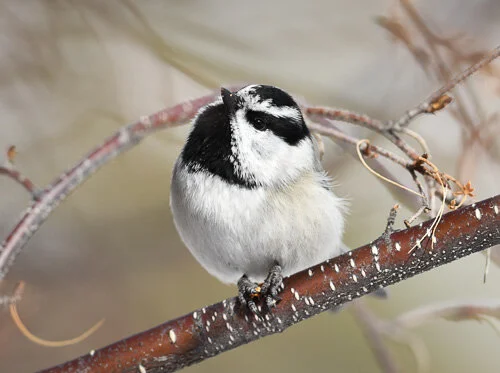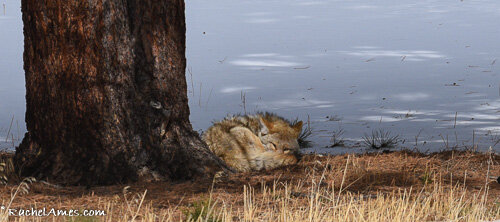Winter Survival Strategies
Long-tailed weasel in its winter coat.
Photos and article by Rachel and Andy Ames, Board Members of the Estes Valley Watershed Coalition.
It has been a cold, dry and windy winter in the Estes Valley so far, and every time the mercury drops, we wonder about all the animals that brave the elements day after day. We put on more clothes, put another log on the fire and turn up the heat, but what do they do? Wild animals that brave winters in the mountains have many tools to deal with the cold weather and lack of food. Below are some of their adaptations to make it through this most inhospitable season.
Fatten Up. If summer is the time of plenty, winter is the season of scarcity. Almost all animals put on extra weight during the summer bounty so that they can afford to lose a few pounds during the winter. During its 3-5 month fast, a bear can lose 15-30% of its body weight. A ground squirrel or chipmunk might lose 30-40% of its summer weight. Capitalizing on the nutritious foods available in the summers allows animals to survive through the winter.
Pika harvesting Alpine Avens.
Stock up. If you can’t count on nature to provide you with adequate food during the winter, cache some! Pikas are some the area’s best hoarders. They create giant hay piles made of summer grasses and flowers, and then munch on them when the winter sets in. An added benefit of this is that plants that are a bit toxic to them in the summer lose their toxicity once they cure, and thus provide great nutrition during those cold and dark winter months. Birds, including nuthatches, chickadees and nutcrackers, are prolific cachers and regularly hide seeds for later. In fact, Clark’s nutcrackers are so good at stashing their favorite seeds that they can raise families in the late winter while most of the landscape is still covered in snow. Pine squirrels are also adept at caching the fall harvest of pine cones.
Mule deer eating Ponderosa pine needles in winter.
Change your diet. For many animals, their preferred foods just aren’t available during the winter. Chickadees, Northern flickers, robins and Townsend’s solitaires are some of the birds that change their diets from mainly insects in the summer to seeds, nuts and berries in winter. Grouse typically eat seeds and forbs in the summer but switch to pine needles in winter. Rabbits, such as the mountain cottontail, change from eating grasses to the stems of bushes. Deer mainly browse on the leaves of bushes and shrubs in the summer but resort to dried leaves, twigs and even pine needles during the winter. As grazers, elk love green grass in the summer, but when fresh grass is not available, they will eat dried grass, twigs and even aspen bark. Moose prefer highly nutritious marshy vegetation and willow bushes in the summer, but subsist on twigs and bark in the winter. Since ungulates are adapted to eat native vegetation, it is important to remember that feeding them bird seed or other human food is actually dangerous to their health and overall survival.
Elk grow long “guard” hairs to stay warm and dry during winter.
Change your Attire. Just like we are taught to dress in layers, hooved animals, like moose, elk, deer and bighorn sheep, grow a denser undercoat and longer outer coat (hollow guard hairs) for additional insulation and water repellency. This coat, along with a good reserve of fat, means that a moose with a winter coat will become heat stressed when the outdoor temperature goes over 23˚F! Mule deer are comfortable from about -4˚F to about 41˚F. Elk have the widest range of comfort, but are thermoneutral between about -4˚F and 68˚F.
Snowshoe hare in its winter attire.
Blend In. For animals that depend on camouflage to keep them safe from predators, or predators that need to sneak up on prey, winter requires a new outfit. Snowshoe hares, weasels and ptarmigan go from brown or mottled to all white so that they blend in with their snowy surroundings. Deer and bobcats make a more subtle change and go from a reddish-brown in the summer to grey in the winter. Elk change from a chestnut-colored coat in summer to a buff colored one in winter.
White-tailed Ptarmigan has snowshoe feathers on its feet.
Wear your Snow Shoes. When you live in an area that has a lot of snow in the winter, it is nice to have a pair of snow shoes! White-tailed ptarmigan grow feathers down their legs and to the end of their toes. Dusky Grouse grow scales on the bottom of their toes so that they can walk more easily on snow. Snowshoe hares have wide and furry feet so that they can travel easily over the snowy landscape.
Conserve Energy. For many animals, winter means surviving by not squandering the precious reserves from the summer’s bounty. It is often said that “winter weakens and spring kills.” Most animals reduce their activity to compensate for their reduced caloric intake. This is why it is extra important not to disturb animals during the winter. They need to conserve every ounce of energy so that they can make it through the season.
Mule deer bedded down on the warm ground.
Use the Ground. The ground is an excellent heat source and stays warm long after the chill takes over the air. Many animals rely on the warm ground, whether it is in their deep hibernation burrows or just a spot on the surface, to help them stay warm. Deer and elk often paw away snow so that they can lie down directly on the warm ground.
Make an Igloo. While animals don’t make actual igloos, many bury themselves in snow to stay warm. Deer will lie down at the beginning of a snow storm and just wait it out as the snow piles over their backs. Ptarmigan dig a hole in the snow so that they can stay sheltered from the harsh conditions at tree-line. Pikas don’t burrow in the snow, but they do rely on snow to insulate their rock dens for warmth. Dry years are tough for ptarmigan, grouse and pikas that rely on the snow for warmth.
Use the Terrain. Taking advantage of the Colorado sun and varied terrain is a great strategy for surviving the winter. Lots of animals go up to the ridges at night (since the air temperature is often warmer than in the valleys) and then they spend time on the south-facing slopes during the day where it is not only warmer, but the vegetation is often more accessible. They often stay out of the wind by hanging out in the trees or on leeward slopes.
Broad-tailed hummingbirds spend their winters in Mexico.
Migrate. If you don’t have what it takes to survive the winters in the Estes area, a good strategy is to take a tropical vacation! Only a few bird species travel all the way to the tropics, but other bird species, elk and deer travel to lower elevations in search of a milder climate.
Hibernate. Ground squirrels, chipmunks, marmots and bears deal with the inhospitable season by going to sleep. These animals find a nice snug spot and then go into a sleep state with a reduced heart rate and metabolism. While bears spend between 3-5 months hibernating, marmots and Wyoming ground squirrels can spend up to 8 months of the year underground!
Mountain Chickadee in winter.
Change your thermostat. Changing one’s thermostat may not always be pleasant, but for an animal that is responsible for making its own heat, lowering the thermostat is a great strategy for conserving energy. While hibernating, a bear can drop its metabolic rate by 50% and its temperature by 12 degrees, and a chipmunk or ground squirrel can drop its temperature to just above freezing. Chickadees are masters of daily thermoregulation and can lower their temperature to conserve energy during chilly nights.
Mountain lion with elk carcass. (Photo from trail camera)
Thrive. Although many animals just hope to survive the winter, the mountain lion is one of the few animals that thrive in winter. Mountain lions can reduce their territory size since their main prey, deer, tend to concentrate into herds and are more sedentary which makes them easier to find and stalk. Deep snow can make deer even more vulnerable to mountain lions, coyotes and bobcats since they can’t run as quickly.
Coyote napping under a tree.
Patience. Of all the strategies to deal with the harsh conditions, perhaps the most effective one is patience. Wild animals have the patience to persist through the cold, dark and windy season. And this patience, along with the trust that the sun will usher in the summer bounty again, is key to making it through the winter season.











